
Rs.10,000 fine, two-year jail term if found using polythene

A 10,000-rupee fine and a two-year term of imprisonment will be imposed if found guilty of using polythene and plastic when the ban becomes legally effective from September, the Central Environmental Authority (CEA) said. It said the production, sale and use of polythene of less than 20 microns would be banned from September 1.
The CEA requested people to use biodegradable and environmental friendly material.
Source – 22/08/2017,DailyMirror, See more at – http://www.dailymirror.lk/article/Rs-fine-two-year-jail-term-if-found-using-polythene-135141.html
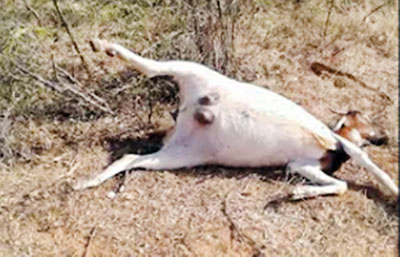
Making a killing with poisoned food
The ongoing drought conditions affecting many parts of the country is taking a deadly toll of animals and inland fish.
Wildlife officials from drought-stricken areas reported hunters had taken to poisoning natural waterholes where animals and birds regularly quench their thirst at Suriyawewa, Weliwewa and in 14 tanks found in Hambantota. This has already led to the death of a deer and seven goats in the vicinity of the waterholes.Unfortunately actions of unscrupulous persons attempting to make a fast buck via this sad situation are posing much danger to both man and beast.
What is worse is the flesh is being sold to villagers, despite the health risks involved.
Last week at the Kalawewa tank in Anuradhapura a haul of dead fish was discovered. The reason behind their death still remains a mystery and a foul odour prevailed in the area as a result of the putrefying fish.
However villagers are reportedly collecting the dead fish floating on the surface, for consumption. The product is also sold in the open market, despite the health risks.
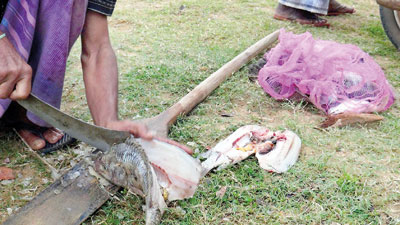
An unscrupulous man cuts up a dead fish which will soon be put on sale
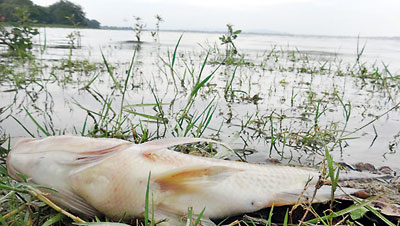
Unscrupulous traders may land this large dead fish which was washed ashore in your cooking pot or mine

Beware, hunters have taken to poisoning animals whose flesh they later sell to unsuspecting buyers
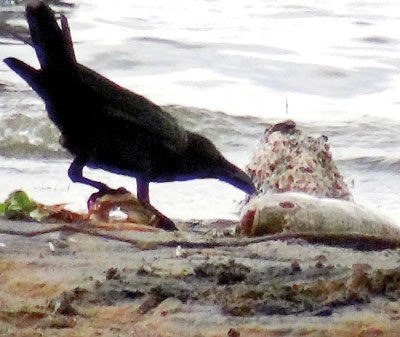
A crow attacking a tasty morsel
Source – 20/08/2017, The Sunday times, See more at – http://www.sundaytimes.lk/170820/news/making-a-killing-with-poisoned-food-255438.html
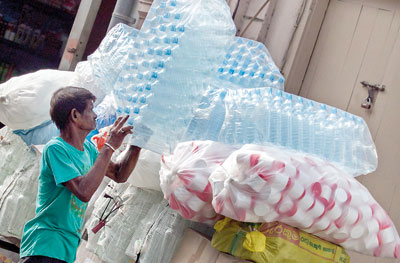
Fishing boats in the regulatory net for plastic waste
Thousands of fishing vessels that carry plastic water bottles and containers will be required to bring them back to shore under new laws being pondered to cut down the plastic waste piles that litter the oceans around Sri Lanka and choke precious marine life.
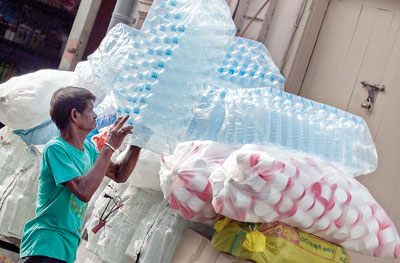
Sri Lanka among top marine polluters
When fishing vessels return to port, crews will be required to account for plastic containers they took on board. There are an estimated 53,900 fishing vessels in the dozen main fishing districts. The industry will be encouraged to use larger — five litres or more — water containers.
The Ministry of Fisheries and Aquatic Resources has joined hands with Marine Environment Protection Authority to bring in these measures.
Director General Christie Fernando said that all fishing vessels will have to account for the number of bottles of water. Boats will only be allowed to have on board containers of five-litre capacity or more and each vessel will be asked to report the number of bottles they have and account for the same on their return.
Fernando said that about 4,000 multi-day vessels cary about 100,00 litres of water to last a month. “They use the water for washing, cleaning, cooking purposes.’’
Fernando said a circular has been sent to all the district fisheries offices and to assistant fisheries directors. The regulation is being drafted and will be incorporated in the act soon, he said.
The Marine Environment Protection Authority said 22 fishing harbours will be monitored together with the Fisheries Ministry.
Chairman Rohana Perera said awareness of plastic waste will be raised. “We are encouraging them to manage, minimise and re-use plastic responsibly.’’
Source – 20/08/2017, The Sunday Times, See more at – http://www.sundaytimes.lk/170820/news/fishing-boats-in-the-regulatory-net-for-plastic-waste-255471.html
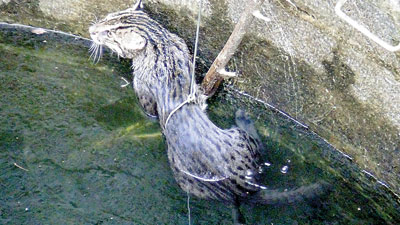
Desperate national parks battle poachers, curtail safaris and campers
National wildlife parks are struggling with an increase in poaching and are limiting access to safari operators and campers amid a devastating drought.
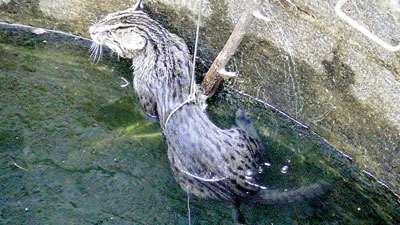 A fishing cat (handun diviya) was rescued last morning when the desperate animal in search of water had fallen into a well in Digampathana, Dambulla . Pic by K. Kanchana Kumara Ariyadasa
A fishing cat (handun diviya) was rescued last morning when the desperate animal in search of water had fallen into a well in Digampathana, Dambulla . Pic by K. Kanchana Kumara AriyadasaThe Yala National Park may even be closed to visitors next month.
There have been reports of animals poisoned at watering holes by poachers at various national parks.
Despite the drought, wildlife officials also say they will provide water only if necessary and instead allow nature to take its course.
Safari jeep operators are complaining of restrictions imposed on them.
The director general of the Department of wildlife Conservation, M G C Sooriyabandara said, park wardens are given the discretion to manage the situation and reduce safari vehicles entering the parks. “Even a one way system has been devised to reduce the same vehicles running up and down,” he said.
He said that the Yala National Park will be closed in September.
Mr Sooriybandara said that officials will rarely intervene in nature and will provide water only if it necessary.
“When we provide water, we choose tanks and watering holes near the safari trails regularly visited by tourists to attract animals, and to make sure that the regularly monitored area is secure from poachers.’’
He said joint patrols are undertaken against wildlife poachers. Wildlife range offices near national parks provide two officials from each office to combine with park rangers and form teams of 10 to carry out raids.
Meanwhile, park rangers and wardens have prepared their own plans.
The warden of the Wilpattu National Park, Chamath Lakshman Perera, said only 30 safari jeeps are allowed at a time, between 6:00 am and 10:00 and then from 2 p.m. to 6 p.m.Mr Perera added that both bungalows and campsites have been closed.
He said 28 small water tanks are being filled up using tanker trucks.
“Lots of poaching activities are happening during the dry months, so we reduce the safari jeeps,’’ he said.
Recently, they detected 13 trap guns and captured four armed men.
A wildlife official said the Yala National Park will be closed next month and will be re-opened after October.
Buddika Widanage, warden at Gal Oya National Park, said it was not badly affected by the drought thanks to the Senanayaka Samudraya. But he said the water levels in the reservoir had dropped.
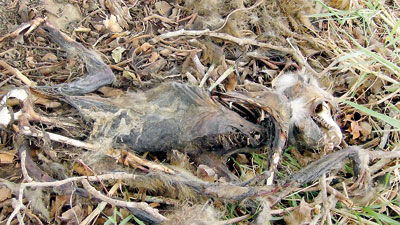
Thabbowa sanctuary: Fast turning into a graveyard for wild animals. Pic by Hiran Priyankara
He said park rangers and officials of the nearby wildlife offices carry out night patrols to catch poachers who set up trap guns or leave poisoned food at watering holes.
Mr Widanage also said campers are only allowed if they bring their own water.
“Even the three-hour boat rides have been cut to two hours” he said.
The Minneriya Park has suffered from the drought since last year, warden Bhathiya Madugalle said. Elephants are the worst effected — less than 10 remain in the park. Animals have moved to Kandalama Park and Ritigala Eco Park.
Mr Mudalige said that there is also less elephant grass.
He explained that water and food are not provided to animals so that the natural balance is maintained and to allow for the survival of the fittest.
Meanwhile, the Independent Safari Jeep Drivers Association claims unfair treatment.
The head of the group, P D Keerthi, said most parks had reduced access. He claimed the operators could provide water and food for anim,als but wildlife officials and the minister would not allow it.
Mr Keerthi also said the one way drive system for safari jeeps could be dangerous in the event of an attack by elephants, when reversing is the only choice.
He complained that although they are regulated, VIPs are allowed roam in the parks day and night.
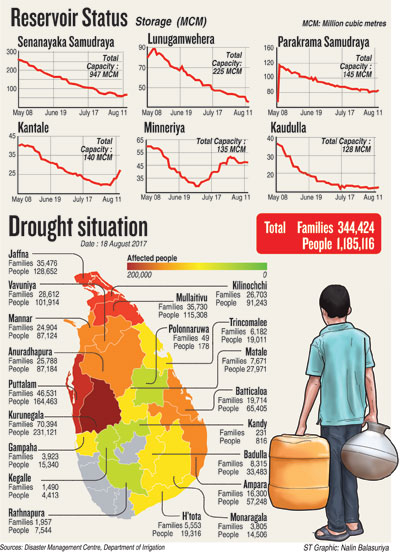
Source – 20/08/2017, The Sunday Times See more at – http://www.sundaytimes.lk/170820/news/desperate-national-parks-battle-poachers-curtail-safaris-and-campers-255478.html

The ‘Glen Falls’ at Nuwara Eliya is no more
The ‘Glen Falls’ which added much scenic beauty to Nuwara Eliya is drying up. The waterfall once synonymous with the town of Nu wara Eliya of which many a hotel and roads are named after is now visible only on rainy days. Area residents have watched as the waterfall dried up before their eyes.
wara Eliya of which many a hotel and roads are named after is now visible only on rainy days. Area residents have watched as the waterfall dried up before their eyes.
Colonial Governor Edward Barnes who designed and developed the town of Nuwara Eliya, set up his official residence in the vicinity of the magnificent 60 -70 metre high falls.
Today this beautiful waterfall is no more.
Despite the waterfall reappearing mainly during the monsoon season, this unfolding disaster does not seem to have attracted the attention of either the populace or those in positions of trust and authority.
Environmentalists claim the over utilisation of this precious water resource for the fast expanding commercial purposes as well as public sanitation, paved the way for the drying up of this once beautiful landmark.
They add potato cultivation on hill tops which commenced in the sixties also contributed to the drying up of the falls whose source spring is situated close to Shanthipura Kala Oya on the ‘Single Tree Mountain Range’ around 6,830 ft above sea level.
The then town of Nuwara Eliya 12.43 sq km in extent, was carved out by the British in 1828 and was originally a town of farmers with one Samuel Baker opening a 1,000-acre farm in 1848.
According to the census of 1881 ordered by then Government Agent (GA) Baros, the town was home to a population of 1,701 persons comprising 270 families.
Today the population consists of 35,000 persons, comprises around 7,500 houses, 3530 commercial buildings and 803 government buildings.
During the dry season water to the city is severely restricted as the sources for drinking water and sanitation needs remain the same as in 1881, other than the few deep-water wells provided via Japan’s JAICA.
The spurt in hotel construction will further stretch the scarce water resources in the area and will undoubtedly aggravate the situation.
If the situation is not tackled with sensitivity even the future existence of the city of Nuwara Eliya remains at risk.

Source – 20/08/2017,The Sunday Times, See more at – http://www.sundaytimes.lk/170820/news/the-glen-falls-at-nuwara-eliya-is-no-more-255450.html

See the agony of this monkey, but what do we do?
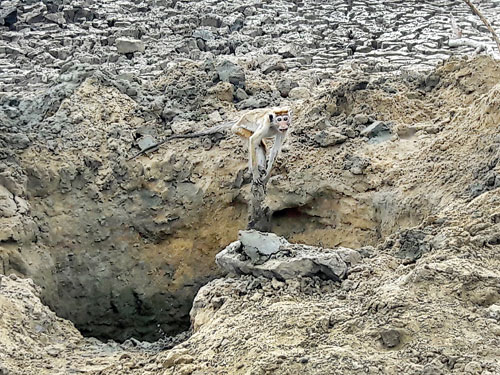
A skeletal monkey with little but skin and bone is seen after it quenched its thirst and struggled out of a temporary well that compassionate people had dug with a cloth ladder for the voiceless and helpless creatures in the fire and fury of the ongoing drought. The temporary well was dug at the Meegaswewa tank in the Thabbowa Park in the Puttalam District. Reports say hundreds of monkeys and other animals have died after suffering for weeks and months in the barren waste. Pic by Karuwalagaswewa Jayaratne.
Source – 20/08/2017, The Sunday Times, See more at – http://www.sundaytimes.lk/170820/news/see-the-agony-of-this-monkey-but-what-do-we-do-255590.html

Death of seven-feet leopard being probed
The Wild Life Conservation Department is probing the death of a seven-feet male leopard in the Deltota, Lulakanda area.
Assistant Forest Range officer G R Dharmarathna told the Daily Mirror that the leopard was found dead on Monday evening following information provided by resident to the area wild life office.
An official from the Wild Life Conservation Department said the carcass of the leopard was handed over to the Peradeniya veterinary surgeon for a postmortem.
He said the reason for the leopard’s death had not been established so far.
The Sri Lankan leopard is a subspecies of leopards native to Sri Lanka that was first described in 1956 by the Sri Lankan zoologist Deraniyagala.
The leopard was listed as an Endangered species on the International Union for Conservation of Nature (IUCN) Red List in 2008 is also an offense to kill, trade or harm a leopard under the Wildlife Act.
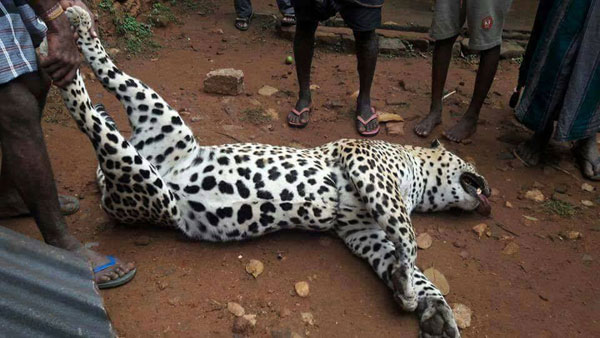
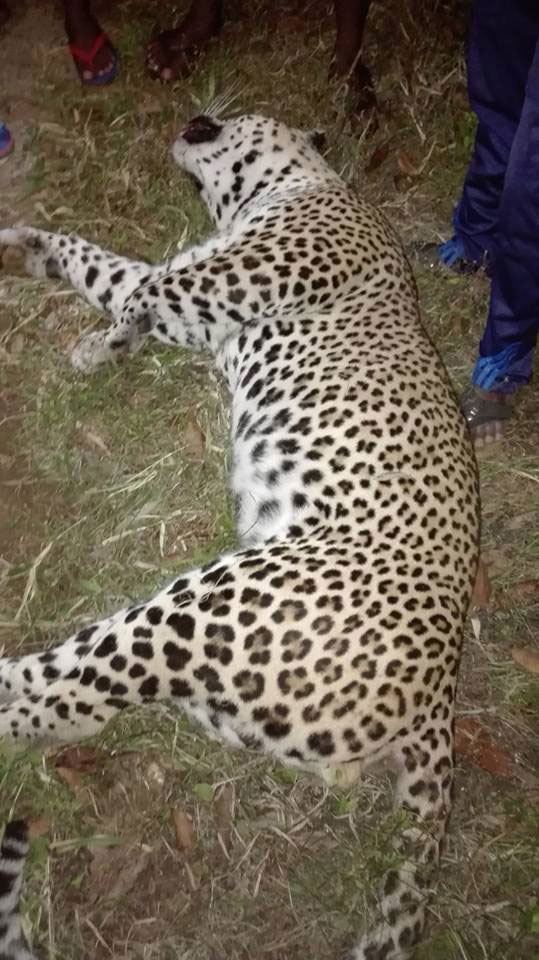
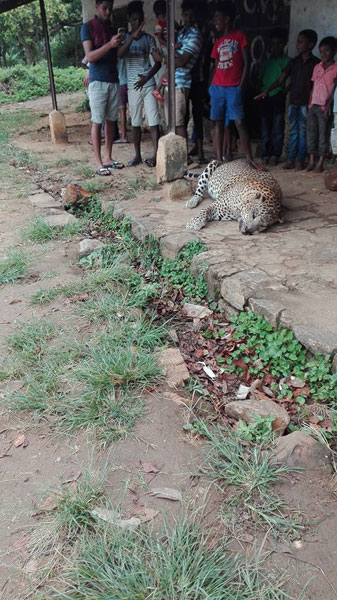
Source – DailyMirror, See more at – http://www.dailymirror.lk/134995/Death-of-seven-feet-leopard-being-probed

Unexpected beauty of SRI LANKA’S MANGROVES

Tourism in Sri Lanka – the tropical island nation just a stone’s throw from the tip of southern India – is on an upswing, thanks to thousands of miles of sugar-sand coastline, lush interiors dotted with tea plantations and the mystique of a place that’s still relatively undiscovered.
And while the country’s pristine beaches, not yet overrun with tourists or towering condos, draw budget and luxury travellers alike from around the world, a different kind of coastal tableau – shallow, shore-hugging waters where mangrove forests grow – is not only worth exploring, but a matter of national attention.
In Negombo, a laid-back beach town roughly 20 miles north of the country’s capital, Colombo, tours of the area’s wetlands start across the street from the Muthurajawela Visitor Centre, in the gray-green waters of the Dutch Canal.
This long, narrow waterway was built in the 18th century to transport spices and now links Negombo and Colombo. As the sun sinks towards the horizon, I climb aboard a modest, motorized boat for a 90-minute tour led by Amal Priyankara, a 26-year-old naturalist and Negombo native.
As our boat slowly plies the canal, Priyankara points out birds that, to an untrained eye, are slow to appear among the leaves, branches and brush.
In the 30 or so minutes, it takes us to reach the end of the waterway, we spot white-throated kingfishers, cormorants, graceful green and purple herons, cattle egrets, red lapwings and other colorful birds.
Eventually, our boat arrives at the canal’s northern mouth and moves into the wide-open Negombo Lagoon, a shallow, 3,000-hectare expanse of saline water surrounded by dense, green, leafy growth.
We cruise at a comfortable clip for several minutes, passing the occasional fisherman and school of silver flying fish. With the sky growing pink and gold above us, Priyankara motions to our captain, who sidles the boat up snugly along a thicket of shrubs, their long, narrow roots reaching down into the water like skinny, splayed fingers. Long, green pods with pointed ends dangle from several of the plants’ branches, like javelins waiting to pierce the placid surface.
“Rhizophora mangroves,” says Priyankara, giving a name to the tangle. Sri Lanka is home to 29 species of mangroves. He’s seen 16.
Importance of mangroves
“Mangroves are a really big topic in my country,” he says. “Schools are teaching kids about them.”
Education is key as mangroves play a crucial role in Sri Lanka’s – and the world’s – coastal ecosystem that extends far beyond the aesthetics they bring to a boat tour. They provide critical shelter for young fish (replenishing coral reefs and fisheries, thus facilitating the livelihood of Sri Lankans who fish for a living) and sequester up to 50 times more carbon dioxide than other kinds of forests, making them indispensable in combating climate change.
They also act as a buffer against tropical storms, reducing damage to coastal communities. (Some studies have shown that areas with more substantial mangrove forests fared better during the 2004 tsunami than did communities without them.) But for all their virtues, mangroves are also at risk, having been dangerously depleted in recent decades thanks in large part to the country’s shrimp-farming industry.
“Sri Lanka generally lacks rules and education about the environment,” says Priyankara.
Women leading the way
That’s all changing now, though, thanks to Berkeley, California-based Seacology, which is about halfway through a five-year partnership with Sri Lankan NGO Sudeesa (formerlyknown as the Small Fisher Federation of Lanka) to teach Sri Lankans about the importance of mangroves.
The organizations provide small-business tools and micro loans to 15,000 local women in exchange for their commitment to help conserve, rehabilitate and replant all of the nearly 22,000 acres of mangrove forests that grow along the country’s coasts.
Anuradha Wickramasinghe, chairman of Sudeesa, says that the organizations targets women in particular because “much of the information and direction in households here is funneled down through them.”
Through the organizations’ Sri Lanka Mangrove Conservation Project, women in 14 districts and 1,500 small communities located near mangrove forests complete mandatory three-day training on mangrove conservation, business management and livelihood development before receiving micro loans that allow them to start or expand their own small businesses.
These range from roadside snack bars and grocery markets to drying and selling fish for household cooking to handcrafting rope ties for fishing boats, to name just a few. In 2016, the organizations opened the Seacology-Sudeesa Mangrove Museum on the grounds of Sudeesa’s headquarters in Chilaw – roughly an hour’s drive north of Negombo on Sri Lanka’s west coast – as a place to educate locals, students and ecologically minded tourists about all things mangroves.
Visitors enter the new museum through a spacious theater where a film offers insight into the ecology, plight and conservation of Sri Lanka’s mangroves.
Inside the sunlit exhibit hall, visitors find dozens of species of mangrove-dwelling creatures – carefully preserved and neatly displayed in jars and on shelves – plus diagrams and illustrations depicting everything from different types of mangroves to the plants’ eco-mechanics.
On nearby Colombo Road, dozens of the program’s micro-loan recipients gather daily in a small, open-air marketplace to sell their wares – fresh fruit and vegetables, packaged local spices, terracotta garden pots, colorful clothes, and handicrafts, among other goods. “We feel very proud,” several of the women say of their business achievements.
Support from Sri Lanka’s Navy
Seacology’s and Sudeesa’s reach within Sri Lanka is extensive. The organizations also run a Northern Regional Centre in Mannar, in the country’s quiet, war-ravaged north, where many of the women who cycle through the program are conflict widows. As in Chilaw, the Mannar facility is home to a mangrove nursery (there are three nurseries in total throughout the groups’ facilities), where seedlings are nurtured and prepped for replanting in wild coastal habitats.
And farther north still, near Jaffna, Seacology and Sudeesa are working with Sri Lanka’s Navy to replant mangroves and to spread the word about conservation throughout the surrounding communities.
Together, the Navy, Seacology, and Sudeesa have planted about 38,000 mangroves around Sri Lanka. For the officers who were enlisted then, this life – marked by conservation and community outreach – is a far cry from the tense civil war that raged here less than a decade ago.
Back on Negombo Lagoon, the sky starts to darken, and it’s time for our tour to end. As we motor away from the mangroves, I take a last look over the side of the boat, marveling at all of the life that the mangroves sustain – both under water and on land. Making our way back toward the Dutch Canal, Priyankara explains that the mangrove ferns that make up the foundation of several small islands within the lagoon were, for a time, on the country’s ‘RedList’, an ominous marker of conservation status for Sri Lankan flora and fauna.
But thanks to protective measures put into place in recent years, they’re now on the rebound and off that list. Surrounded by the lush beauty of Negombo Lagoon, one can’t help but hope that, as tourism continues to flourish in this tiny island country, so, too, do its precious mangroves.
CNN





Source – Nation, see m,ore at – http://nation.lk/online/2017/08/12/unexpected-beauty-of-sri-lankas-mangroves.html

Wildlife officers rescue ‘Fishing Cat’ from well

Wildlife officers from the Department of Wildlife Conservation’s (DWC) Sigirya office have managed to successfully rescue a large Fishing Cat (Handun Diviya) which had fallen into a well at Digampathana in Dambulla.
The incident took place yesterday (17). Villagers had seen the Fishing Cat fallen inside the well unable to get out. They had at first tried to rescue the animal themselves, but given the danger involved to the animal and themselves, had alerted wildlife officers.
DWC officers had arrived within minutes and had managed to successfully pull the animal out of the well using a noose made of wire. The Fishing Cat had then freed itself from the noose and fled into the jungle.
Source – 18/08/2017, TimesOnline, see more at – http://www.sundaytimes.lk/article/1029810/wildlife-officers-rescue-fishing-cat-from-well

Indira Gandhi Zoological Park initiates steps to bring 10 different species including Pygmy Hippo from Colombo

The Indira Gandhi Zoological Park has initiated steps to bring 10 different species of wild animals and birds from Israel, Colombo, Germany, Czech Republic and Japan zoos this year, the Deccan CHronicle reported.
Zoo curator B. Vijaya Kumar was quoted as saying plans were underway to bring a Pygmy Hippopotamus from Colombo. Further, he said other animals would be Chapman Zebra, Oliver Baboon from Israel, Fishing cat, Red Necked Wallabies, Scarlet Macaw, Military Macaw from the Czech Republic and Greater Flamingos from Japan would be brought to the zoo park in this fiscal only.
Under the International Animal Exchange Programmes, zoos can bring inmates from other places after obtaining permission from Central Zoo Authority. “Impressed with the vast natural habitat of the zoo, the Israel Nature and Parks Authority (INPA) had shown interest to give four zebras,” he said.
Source – 16/08/2017,TimesOnline, See more at – http://www.sundaytimes.lk/article/1029638/indira-gandhi-zoological-park-initiates-steps-to-bring-10-different-species-including-pygmy-hippo-from-colombo



